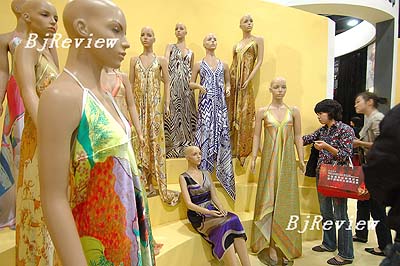|

The Chinese textile industry, long a high exporting sector, is showing signs of a slowdown. According to statistics released by the National Development and Reform Commission (NDRC) on October 30, in the first eight months of this year, China's exports of textiles and apparel were $111.73 billion. This represents an increase of 19.46 percent year-on-year, though a decline of 5.21 percentage points compared with the growth rate during the same period last year.
Analysis made by China National Textile and Apparel Council (CNTAC) found that the slowdown came mainly from a decrease in export volume. In the first eight months, the export volume grew 11 percent, 4 percentage points lower than last year.
"The industry is changing from its high-growth period after China's WTO accession to a normal growth period," said Du Yuzhou, Chairman of the CNTAC.
Three factors
According to Du, the industry has been heavily influenced by factors such as yuan appreciation, the adjustment of tax rebate policies and international trade friction.
From January to August, the renminbi appreciated 3.16 percent against the U.S. dollar. Statistics from the CNTAC indicate that when the renminbi appreciates 1 percent, profits of cotton textiles, wool textiles and apparels decrease by 3.19 percent, 2.27 percent and 6.18 percent respectively. Renminbi appreciation caused the industry to lose 30.6 billion yuan ($4.08 billion) in the first eight months. This year, China's central bank also raised interest rates for savings deposits and loans five times, meaning textile companies had to pay an extra of 8.9 billion yuan ($1.19 billion) in interest.
As of July 1 this year, the Chinese Government reduced the tax rebate rate on apparel as well as viscose fiber and related products down to 11 percent and 5 percent respectively. On July 23, the Ministry of Commerce (MOFCOM) and the General Administration of Customs jointly announced a new list of processing trade products classified to be restricted for export. Exporters of products on this list must pay the full amount of an export guarantee deposit. There are 1,539 textile products included on the list, accounting for 83 percent of the total.
The EU's quota mechanism on Chinese textiles will be annulled on January 1, 2008. According to an agreement between China and the EU, the two parties will adopt a double-check system. The China Chamber of Commerce for Import and Export of Textiles, the CNTAC and the China Association of Enterprises With Foreign Investment jointly issued qualification standards for companies exporting textiles to the European market subject to the new system. The standards include six indicators, according to which about 6,000 companies are qualified to export textiles to the EU market. Previously, more than 10,000 companies were qualified to export to the EU.
These restrictions will lead to the continuous decline in the growth of textile exports. In Du's opinion, it will drop to10-15 percent, from the previous annual average rate of over 20 percent.
A low-profit industry
The Chinese textile industry is a major traditional industry. At present, China is the largest textile exporter in the world. In 2006, the trade surplus of China's textile industry stood at $129.2 billion, contributing 71 percent to the country's total trade surplus.
However, China's textile industry is not yet fully developed. Most textile enterprises, especially apparel producers, are processing oriented, serving as original equipment manufacturers (OEM). The MOFCOM statistics show that exports of Chinese textiles with independent brands only account for 10 percent of the industry's total exports.
There are now more than 30,000 textile enterprises in China, most of which earn processing fees of about 10 percent of the total costs. Chinese textile exporters only get 3-5 percent of profit, while more than 90 percent goes to importers, retailers, whole sellers, brand owners and related logistic companies.
The textile industry is labor-intensive. China's textile industry employs 20 million people and its labor cost advantages are weakening.
Gao Hucheng, Vice Minister of Commerce, says that according to a report released by Werner International-a global management consultancy specializing in the fiber, textile and fashion industry-traditional coastal textile-producing areas are witnessing rising labor costs, closing in on the threshold of $1 per hour. Ten years ago, the cost was less than $0.3 per hour and five years ago less than $0.6 per hour. Regionally, textile labor costs in Viet Nam, Cambodia, Bangladesh and Indonesia were $0.29, $0.36, $0.22 and $0.36 per hour, respectively, only one-third that of China on average.
The world's textile market
Although the profits of China's textile enterprises are low, the country provides a huge market for the world's textile industry. Development of China's textile industry drives imports of related dress materials, cotton and textile machinery.
According to MOFCOM statistics, in 2006 China imported $18.1 billion worth of textiles and apparels and $4 billion worth of textile machinery, up 6 percent and 19.2 percent, respectively, year-on-year. China is also the largest cotton importer in the world, importing $4.87 billion worth of cotton in 2006, a rise of 52.3 percent over a year ago. At the same time, it is the second largest cotton exporter to the United States.
| 